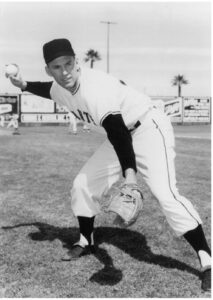Editor’s note: This article originally misidentified a photograph of Boeing Bomber player Daryl Spencer as Ernie Logan. It has now been corrected.
They called him “Moose.”
And there was good reason. Ernie Logan stood two inches above six feet. His 200-plus pounds were wound tightly on that tall body. His hands? Quick and strong. In his first time at bat in the AA Southern Association, he hit a grand slam home run. Later in the same game, he hit a ball over the right field wall that traveled farther than any before or since, awed Atlanta sportswriters reported.
Those same hands were just as quick with pen and paint brush. He turned out dozens, maybe hundreds, of paintings. Many were of early 20th century farm scenes. He was a cartoonist, often lampooning baseball. They grasped drum sticks in the University of Oklahoma marching band and, later, in the Coast Guard. They typed and illustrated the book he published about Canada geese. He used them for emphasis when speaking on behalf of his beloved Methodist church.
While in the Coast Guard he appeared briefly in the movie “They Were Expendable” with John Wayne and Robert Montgomery. “In the movie he was a wounded sailor in a hospital,” his widow, Dorothy, recalled. “We went to watch the filming but couldn’t tell who he was. His face was covered with bandages.”
His early fame in Wichita came on the baseball diamond as a Boeing Bomber. Whether the 1955 Boeing team was the best semipro team ever put together might be questioned. But it was the only one from Kansas ever to win the Global World Series in Milwaukee, and that’s trophy enough.
Now a member of the Kansas Baseball Hall of Fame, Ernie was typical of the team. The main difference between semipro and professional baseball players in that era was not talent. It was who paid their salary. In the Bombers’ case, it was the Boeing Co., long a sponsor of strong baseball teams. All but three of the global champion team members were Boeing employees, Ernie among them. He was a technical writer and illustrator as well as the baseball team’s regular right fielder..
He also was typical in having played as a professional including his last of five years at AAA Columbus just one step from the majors. There he had what Dorothy called “a decent year.” (He hit .278 with 14 home runs that season.) “He made $900 a month there,” Dorothy—or Dot as she’s best known—recalls. “That was a lot of money for the time, like maybe $10,000 now.”
“But at the end of the season he said, ‘It just isn’t worth it.’” So the family packed and drove to Kansas and to the then giant B-47 manufacturer on South Oliver. That ended the gypsy-like life of a baseball family. That last summer after being with Ernie during spring training in Florida for Cardinal minor leaguers, she packed the two kids in the car and made the two-day drive north to Ohio for the season. “It was scary,” she recalls.
Coming back to Kansas did bring the Logans much closer to their roots. Both were born in what once was the Cherokee Strip of northern Oklahoma, he at tiny Meno, she at even smaller Nardin. Ernie later moved with his family to nearby Garber and Dot to Deer Creek. They met at Northern Oklahoma College in Tonkawa after Ernie left OU. They started 66 years of marriage in 1942 as war was breaking out. In 1943, Ernie began a three-year tour in the Coast Guard. He started his baseball career after the war.
While Ernie, who died at 86 in 2009, was busy with his pursuits, Dot was also. Besides being a full-time mom to two, she was active in the PTA and chairing the Republican Women’s Club. She fondly recalls meeting such people as Senators Bob Dole and Nancy Landon Kassebaum at GOP functions. Today, daughter-in-law Sheril Logan keeps the family name alive in politics. She is president of the Wichita board of education.
Dot’s still busy. Last October, she celebrated her 100th birthday and now she’s working on how to best use her collection of her husband’s artwork. It adorns the walls of her third floor apartment overlooking a golf course at Reflection Ridge Retirement complex. It fills well-organized notebooks and plastic tubs.
She’s also in charge of the trophies and certificates for such things as all-star teams and the Kansas Hall of Fame. Pointing across the room, she says “there are seven baseball trophies in that cabinet” and offers to show them.
On the day we visited, she was planning her outfit for the retirement home’s prom dinner and dance that night. “I can’t remember the last time I wore a dress,” she said, preferring slacks now.
“And I’m not sure about the dance.” Yet she also was pleased to be going while acknowledging that many of the home’s activities seem slanted toward younger residents.
Guarding all her treasures is one of Ernie’s autographed and custom-made Louisville Slugger bats, held in one piece with black electrical tape. “After he broke it in a game, he gave it to someone who carefully put it back together then brought it back to me years later,” she explained.
But she’s afraid it wouldn’t help much in case someone broke in. “I doubt that I could reach it in time,” she said with one of her frequent laughs.
Bob Rives is the author ” Baseball in Wichita,” History Press (2004). Contact him at bprives@gmail.com.
Global tourney was Hap Dumont idea
The Global World Championship won by the 1955 Boeing Bombers was dreamed up by Raymond (Hap) Dumont, who founded Wichita’s National Semipro Baseball Congress tournament during the Great Depression. The Bombers defeated teams from Mexico, Colombia, Hawaii (twice) and Saskatoon on their way to the title.










